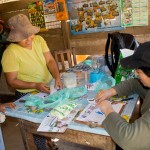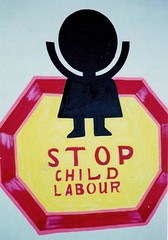On the 3rd day, we visited several collection centers around Quevedo. These centers are where farmers in the area drop off their beans and collect their money. Usually the beans are already fermented and dried, but if the farmer doesn’t have the equipment or wants money quickly, he can drop off the fresh baba. These collection centers are very convenient for the farmers but leave a lot to be desired in terms of promoting quality beans.
In two of the three collection centers the beans were dried using powerful blowers instead of natural sunlight. Beans are “blow dried” to hasten the drying process so that it takes 10 hours rather than 4 days. I asked Steve Devries his opinion regarding this method, and he is convinced that it kills a lot of flavors that come out of drying the beans naturally.
We sampled some beans at random and found that many of them were under fermented as well. The beans we split open at Samuel’s farm were brown with nice even cracks, while these were mostly purple. Under fermented beans means the chocolate will taste astringent and will ultimately have to be masked with lots of sugar or vanilla in order for it to be palatable.
Steve pointed out that bean quality is compromised when you mix all the beans from different farms together, because they will have to be roasted to the most common denominator. The fact that some farmers bring in perfectly fermented beans won’t matter because others might not care as much about the quality of their beans. This problem is worsened by the fact that collection centers accept both Arriba beans and CCN-51. We noticed that very little is done to prevent them from mixing once they got past the door. So, even if your bar of chocolate claims to use only Arriba beans, chances are it’s not.
Probably the biggest issue threatening quality is cleanliness. I saw animal feces on the floors of the dryers at one (a good argument agains raw chocolate) and at another, there were chickens nesting in an unused fermentation bin. At one point we saw workers scrambling to clean up an overflowing toilet that threatened to leak on coffee beans which were laying out on the floor to dry! Minutes later we watched in amazement as trucks drove over the those coffee beans. This is just one example of why it’s very important to know where you food comes from!
I felt that the visit to these centers made one thing very clear: there is really no better way to insure quality and consistency than by working directly with a farmer.





























 It was getting quite dark now and the kids were bored and hungry. Luckily dinner was ready. Herminia cooked us a wonderful fish dinner. One for each of us! They declined to join us for dinner because they had friends visiting later and wanted to eat with them. I felt bad eating my whole fish in front of the family, but I was starving and the fish was delicious and that overrode all sense of propriety.
It was getting quite dark now and the kids were bored and hungry. Luckily dinner was ready. Herminia cooked us a wonderful fish dinner. One for each of us! They declined to join us for dinner because they had friends visiting later and wanted to eat with them. I felt bad eating my whole fish in front of the family, but I was starving and the fish was delicious and that overrode all sense of propriety.


